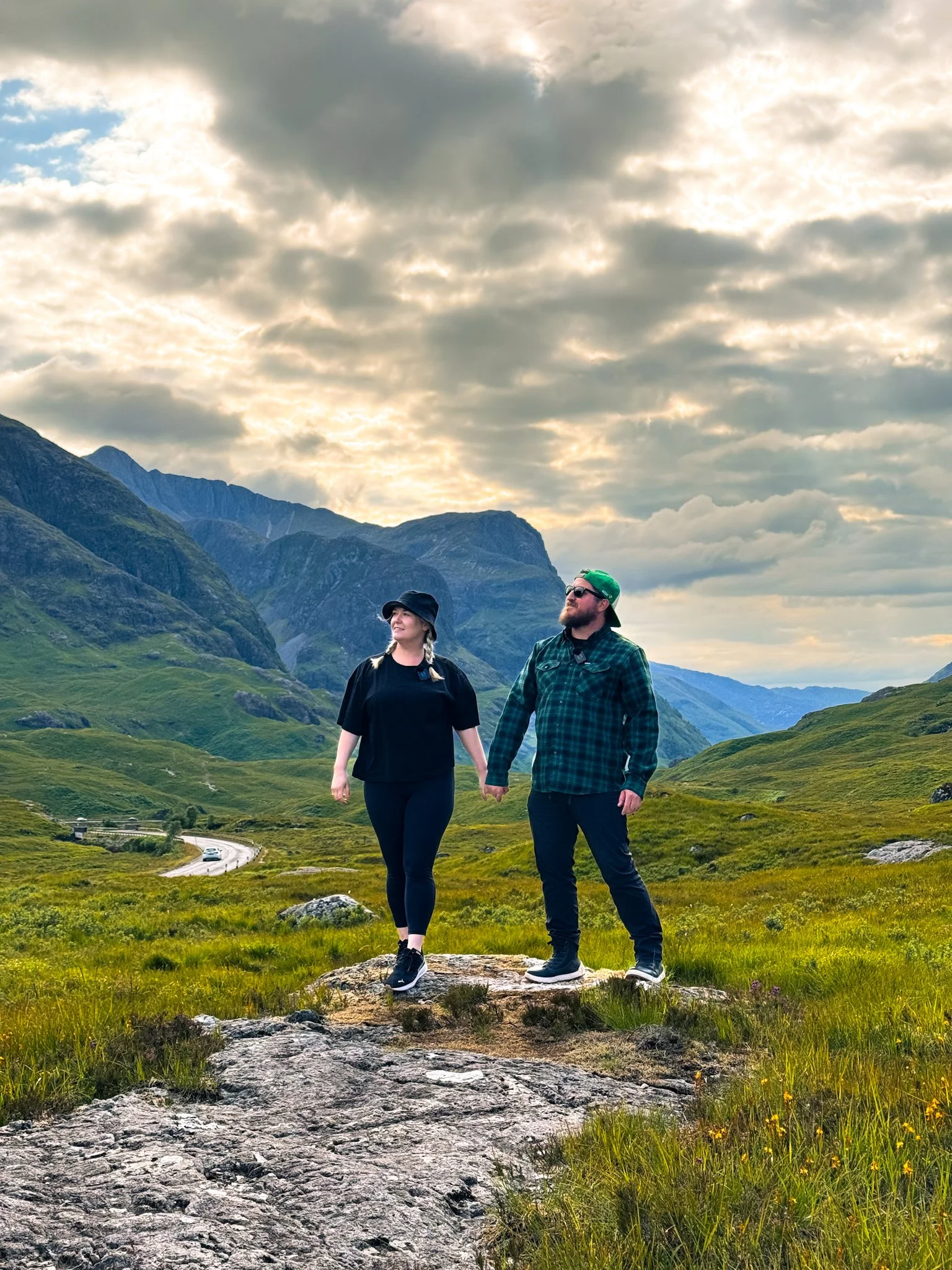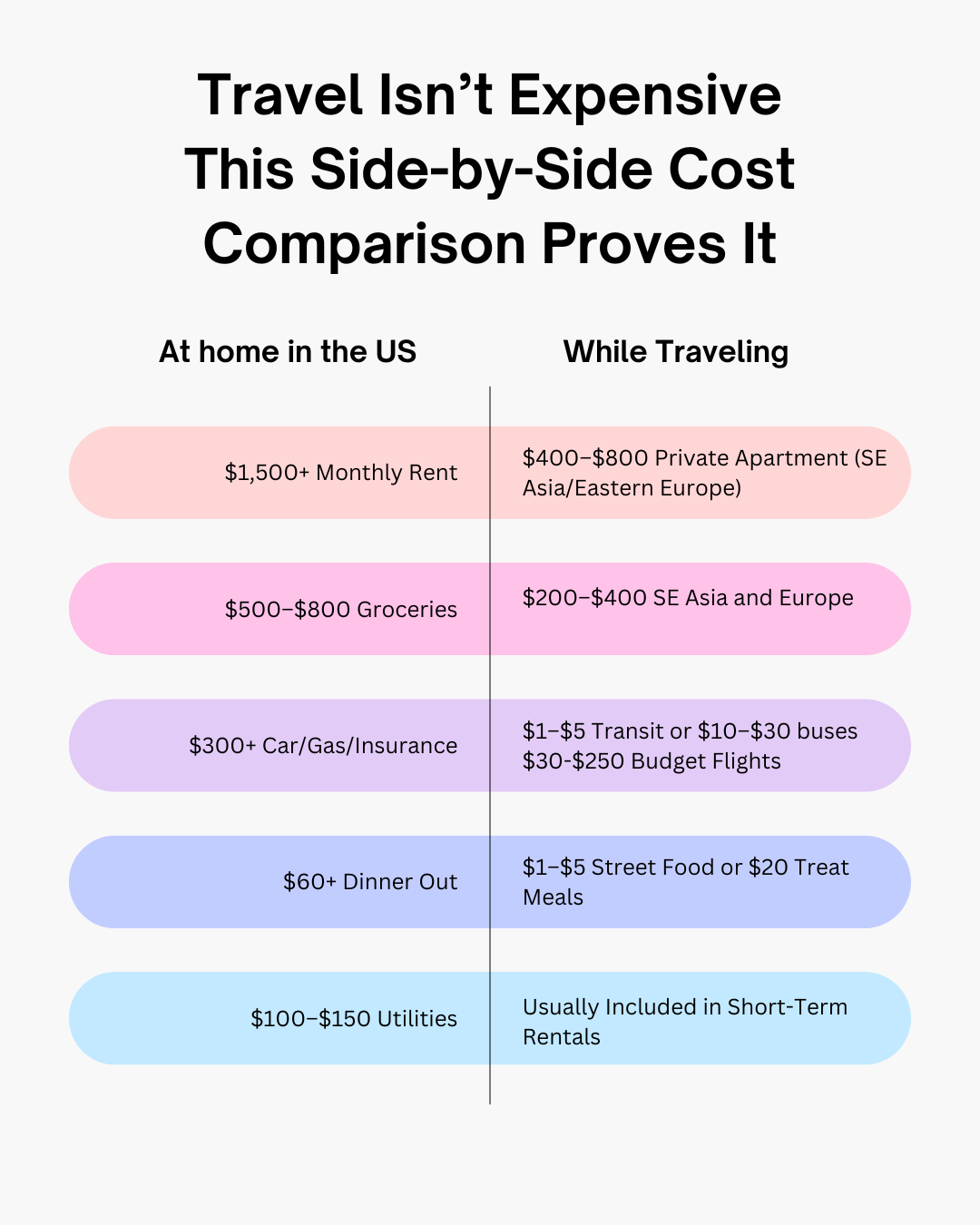How We Afford Long-Term Travel Without Remote Jobs or a High Income
If you’ve ever dreamed of quitting your job and seeing the world—but told yourself it’s only for rich people or remote workers—this is for you.
Over the past four years, we’ve designed a lifestyle that lets us travel for months at a time without working online or earning six figures. We didn’t win the lottery or inherit anything—we just made travel a priority and changed the way we saved, spent, and planned.
It wasn’t always easy, but it’s more doable than most people think. And if you’ve ever said, “I wish I could do that”—you probably can.
The Turning Point
For a long time, we saw travel as something other people got to do—people with more money, more flexibility, more… luck?
So we turned to YouTube to explore the world. Before our night shifts, we’d sit on the couch and ask each other,
“Where do you want to go today?”
We’d search for a place—Japan, Morocco, Croatia—and watch other people explore it. It became a ritual, a way to make the monotony of everyday life feel a little more exciting.
Then one night, I turned to Lemon and said,
“We could do that.”
He looked at me. “Do what?”
“Save up. Quit our jobs. Travel the world.”
Without hesitation, he said, “Okay.”
I told him not to joke—because if he said yes, I would make it happen.
He said, “Let’s do it.”
And that was it. From that moment on, every decision we made—every shift we picked up, every dollar we didn’t spend—was with one goal in mind: traveling the world for a year.
Around the same time, we decided to start documenting our travels on YouTube. We figured if we were going to do something this big, we might as well bring people along. We hoped it might inspire someone else to take the leap—and maybe, eventually, earn a little income from it. But even if no one watched, we loved the idea of having those memories captured forever. The videos became our way of storytelling, remembering, and staying connected to the journey.
Want to see what this lifestyle actually looks like?
We’ve been documenting our travels on YouTube since day one.
Subscribe to our channel here to follow our journey around the world—no remote jobs, just real-life travel.
What This Life Has Looked Like
That decision led us to save for nearly two years (thanks, COVID) before we set off on our first long-term trip: 11 months across Asia and Europe, funded with $38,000 in savings (and $5,000 each in an emergency fund).
Then, we came home, moved in with family, worked for four months, and hit the road again—this time spending four months in Asia exploring Japan, Malaysia, Singapore, South Korea, Bali, and Taiwan.
After that, we came home again, worked for seven months, and then moved to London to stay with friends and explore the UK for five months—before spending two more months in Thailand.
Since October 2024, we’ve been back in the U.S., working and saving all over again—for another long trip in 2026.
This is the rhythm we’ve built: Work → Save → Travel → Repeat
Travel Isn’t a Vacation
We don’t treat travel like a vacation—we treat it like real life.
That means:
Traveling on a mid-range budget (not budget backpacker or luxury- somewhere in the middle)
Estimating a daily budget and sticking to it
Booking based on geography to avoid expensive, unnecessary flights
Staying in places long enough to slow down and save
When we’re home, we both work full-time in the restaurant industry. We’re lucky to have a company that brings us back when we return, but there’s no remote work or passive income here (besides a little income from our YouTube channel)—just a cycle we’ve committed to.
It’s not always glamorous, but it’s intentional.
And for us, that’s the key to making it sustainable.
What It Took to Save $38,000
Before our 11-month trip, we didn’t just guess at what we might need—we built a plan.
We created a location specific spreadsheet and researched what all of our estimated expenses would be: food, tours, flights, accommodations, travel insurance, etc.
Then, we tracked our weekly/monthly expenses to see what we were spending and identify areas where we could cut back.
Then we worked backwards:
$38,000 saved
2 years to save it
Weekly and monthly check-ins to track our progress
We used two spreadsheets:
One to estimate costs
One to track what we were actually saving
💡 Want to try this yourself?
Use our Master Travel Budget Planner to build your own trip budget. It’s completely free and when you claim it you will get our weekly travel newsletter filled with travel news, miles and points tips AND food and cocktail pairings from all over the world!
What We Gave Up
This lifestyle isn’t just about what we want do—it’s about what we’re willing to give up to get there.
Here’s what we do when we’re in saving mode:
Cook all our meals—7 days a week
Bring lunch to work
Stick to a $125/week grocery budget
Cancel subscriptions or join family subscriptions
Use Mint Mobile (paid for the year to get a discount)
Live with roommates or family to cut down rent
Buy second hand clothing
Skip any social event that’s not at someones house
Literally stay home as much as possible because the second we walk out the door we are probably going to spend money
The more discomfort we’re willing to handle at home,
the more comfort we can afford on the road.
It’s not just about discipline—it’s about trade-offs. And we’ll trade takeout and Target runs for Thai night markets any day.
What Keeps Us Going
Saving for travel can feel like a long, lonely road. Here’s how we keep the momentum:
Watch YouTube videos of places we want to visit
Use the Wanderlog app to keep track of places we want to go
Check in weekly on our savings goals
Remind ourselves how far a single decision—like skipping a $100 dinner—can go abroad
That one mindset shift has helped us fund some of our favorite memories.
We don’t have endless willpower—we just know what we’re working toward.
The Truth About Travel Costs
Let’s bust the myth right now: long-term travel doesn’t have to be expensive. In fact, in many parts of the world, it’s actually cheaper than simply existing in the U.S.
When we’re traveling, we’re not paying rent, utilities, car insurance, or constantly shopping on Amazon. We’re living differently—and in many places, it costs less to live day-to-day.
Here’s what we’ve found over and over again:
Regions Where Your Money Goes Further
Some of the best places to stretch your budget while still living well:
Southeast Asia: Thailand, Vietnam, Malaysia, Indonesia
Eastern Europe: Albania, Bulgaria, Georgia, Romania, Poland
Parts of Latin America: Mexico, Guatemala, Colombia
Off-the-path Balkans: Bosnia & Herzegovina, North Macedonia, Serbia
We’ve lived off $35 a day in Asia and $50 a day in Europe while still eating well, taking day trips, and staying in clean places. You don’t have to rough it—you just have to research.
Slow Travel = Big Savings
One of the biggest money-savers is traveling slowly. When you stay longer:
You get weekly or monthly discounts on Airbnb and guesthouses
You avoid constant transportation costs
You settle into local routines, often times cook more, and experience local life
You experience less burnout from moving too fast
Plus, it just feels better. Rushing from city to city every 3 days is exhausting and expensive. Slow travel keeps your costs down and makes the experience more meaningful.
The Mindset Shift
Travel becomes affordable when you stop comparing it to a two-week vacation. When you plan, budget, and treat it like a lifestyle, the math starts to work in your favor.
And once you stop assuming travel is expensive and start running the numbers, you might find what we did: It costs less to explore the world than it does to stay stuck in one place. The biggest barrier usually isn’t money—it’s mindset.
When you run the numbers and realize this lifestyle is within reach—with a lot of hard work—the doors start to open, and you begin to see that life can be so much more than the traditional path society tells us is the only option.
Curious how we actually plan these trips? Watch the video below!
Facing the “What Ifs”
Most people don’t get stuck because of their bank account. They get stuck in the “what ifs.”
What if we can’t find jobs when we come back?
You will. You’ve done it before, and you’ll do it again. We’ve returned home multiple times, picked up work, and started saving all over again.
What if we run out of money?
Then you go home. You regroup, you reassess, and you start again. It’s not failure—it’s part of the cycle.
What if we miss out on career growth?
Maybe you will. But maybe you’ll grow in other ways—ways that don’t show up on a resume but shape who you are forever.
What if something goes wrong?
Something will. Flights get delayed. Plans change. You figure it out. That’s part of the adventure.
The truth is, what ifs are just fear wearing a disguise. The better question is: what if it all works out? What if you actually build the life you’ve been dreaming about—and realize you never needed to do it the “normal” way?
We’ve asked all the scary questions.
And we’re so glad we didn’t let them stop us.
A Different Kind of Life
We’ve slept in a van on the coast of Scotland. Watched the sunrise from a hot air balloon in Turkey. Drank $1 lattes in Eastern Europe and homemade rice wine from an auntie in rural Vietnam.
But it’s not all dreamy landscapes and storybook moments.
We’ve also carted around a loaf of bread and a jar of peanut butter and jelly through multiple countries in Europe—on buses, trains, and sidewalks—because it meant we didn’t have to buy lunch every day. In France, the only way we could afford to stay a full month was by renting a room in someone else’s apartment. In Serbia, we sat on a broken-down bus for hours in 90-degree heat with no AC, no idea when we’d be moving again, and nowhere else to go.
It’s not always comfortable.
But we would trade these kinds of “problems” for the traditional ones back home any day.
Because for us, this life—imperfect and unpredictable as it is—is still the one that brings the most freedom, clarity, and joy. And we wouldn’t trade those memories for anything. We don’t have a mortgage. We don’t have remote jobs. We just have a system, a shared vision, and a willingness to do things differently.
If you’ve ever felt like you were meant for something more—this might be it.
You don’t need a trust fund. You just need a plan!
Don’t forget to subscribe to our YouTube by clicking here and download our FREE master budget planner by signing up for our weekly travel newsletter here.





